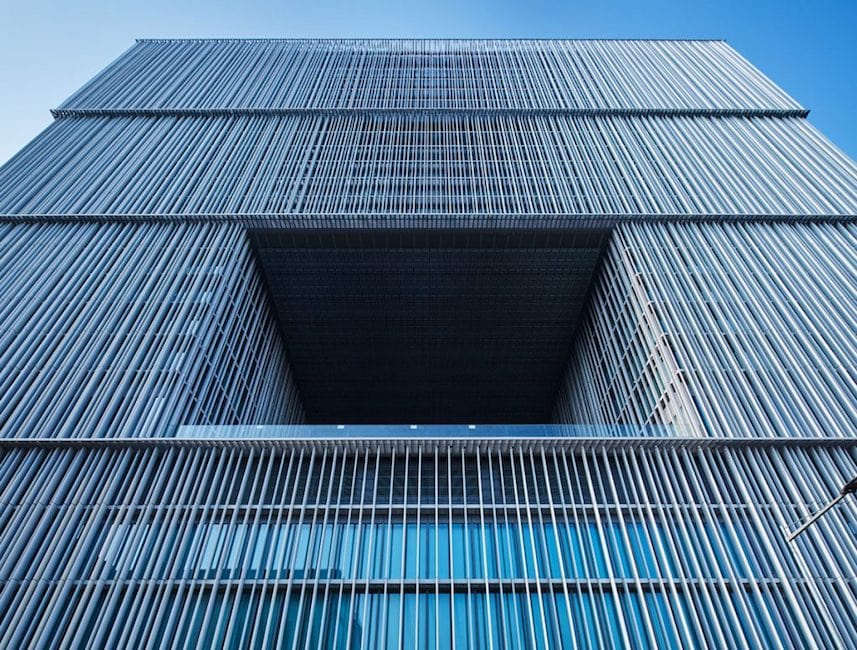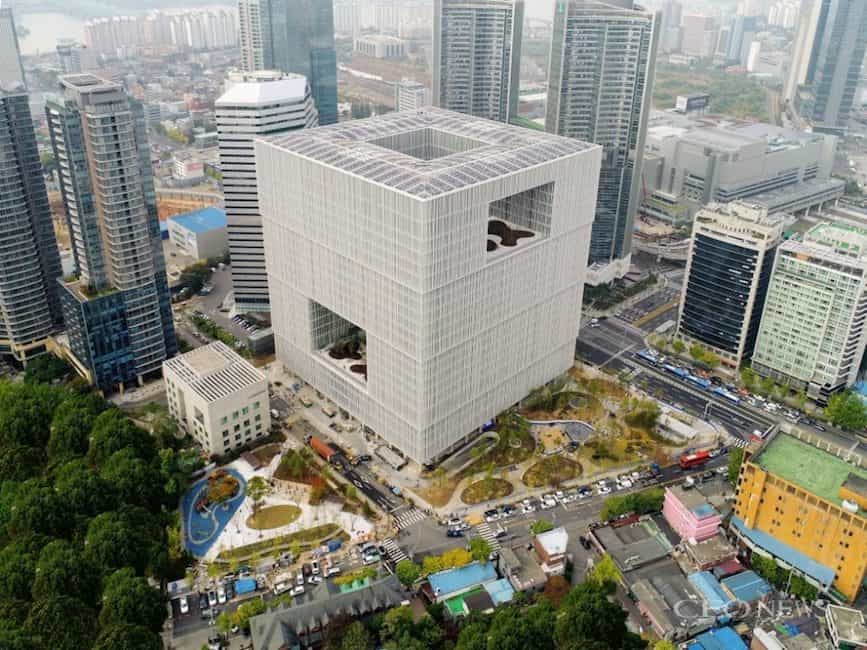
Amorepacific Headquarters / David Chipperfield Architects. Image © Noshe
Facades are the visual interfaces between the outside and the inside of a building. The facade of a building can offer not only a visual experience, but it can also showcase the brand of architectural work done. It can also serve a function in creating a comfortable environment and protection against external agents.
This article will look at the types of the “smart facade” that uses glasses and walls, their features, and their advantages.
For starters, let us define what smart facade means. Archdaily.com considers a facade smart when it adapts to the environmental situations and transforms itself simultaneously. The change happens through its passive or active components, which adjust to different conditions. A smart facade can respond to changes that occur on the outside and inside of the building. The nature of this transformation involves three key things:
- Balance of maximizing natural light
- Sheering from the adverse radiation
- Control ventilation and thermal heat
In hot areas, a facade ensures maximum ventilation, shadings, and openings. At the same time, in cold places, it allows the sun to enter maximally. This shift maintains a balanced atmosphere; the facades even change their aesthetic appearances, hence the term “smart” facades.
A case study shows that our bodies function efficiently when the thermal heat is balanced, i.e., when our body’s temperature balances the heat we lose. Smart facades should coincide with the environmental conditions of the area. Secondly, architecture should create structures that match these qualities.
Research shows the ratio by which heat loses to buildings includes 35% through the walls, 15% via floors, 25% by windows, and 25% via the roof. However, the structure controls how fast or slow the heat will be lost. They do this by the materials they use and the technicality of the architecture.
Some preferred materials include polystyrene, polyurethane, ceramic, and mineral wool. The materials contain lots of vacuum; consequently, the air in the spaces makes it easy not to conduct heat. Secondly, materials with high thermal inertia can hold heat and release it back to the environment simultaneously.
With that in mind, let’s discuss the four avenues that lose or gain heat, namely, floors, walls, roofs, and windows.
First, let us consider the floor. The insulation will minimize the heat exchange between the ground and the premises; the kind of material used will significantly affect those in the building’s temperature. Next is the walls. In addition to the elements mentioned earlier, plaster is also an excellent insulator; the thickness and the coating, influence the room’s temperature.
Third, the roofing used should coincide with the environment. Let us cite tropical areas, for example. Using light materials as well as bright colors for finishing is essential. However, in cold regions, thick slabs and dull colors can be adapted to aid in retaining heat. Fourth and last, the windows. The glasses used can either block or allow natural light or solar radiation, hence influence the environment; the same applies to facades, as the article will later discuss.
Different Types of Glasses and Their Features
With the recent technological advancements, there are progressed improvements made on glass. Below are some of the examples and their features that are unique in each design.
Tinted sage glass
This glass technology from Saint-Gobain has an electrochromism nature that enables it to change color depending on its voltage. The glass makes it possible to digitally control the color to block or control the amount of radiation getting in. It uses sensors that make physically controlling it from a mobile phone likely. The controlled tinting keeps the interior environment favorable and doesn’t affect contact with the outside surrounding through viewing.
PRIVA-LITE
Like its name, this glass promotes the building’s privacy while still maintaining a conducive temperature environment. PRIVA-LITE is controlled by electricity to alternate between its transparent and translucent nature. The technology has two significant advantages, privacy from the outside world while allowing the natural light to stream. Secondly, using the facade as a backdrop, where you can project presentations.
EGLAS
The integrated invisible heating solution technology originated in Finland; EGLAS can provide heat while maintaining the coolness outside nature, thus preventing condensation, even snow melting.
Self-cleaning glass
This type of glass reduces the accidents and hassles that come with cleaning facades. This type of glass uses a transparent material for the coating that enables the power of UV rays, contained in sunlight, and rainwater to control the dirt that accumulates on the outside of the windows. The radiations convert the decomposed dirt into water, which then washes away, making this facade very easy to clean and maintain a pleasant temperature environment.
Different Types of Walls and Their Features

Amorepacific Headquarters / David Chipperfield Architects. Image © Noshe
The walls highlighted are innovations that are flexible and can quickly adapt to various environments. Especially with the recent climatic changes due to global warming, these walls’ nature makes them applicable.
Spong3d
The idea behind Spong3d is to maintain thermal heat control throughout all seasons in a year. The technology involves materials that are incredibly void to make it possible to store heat, and a movable liquid connected to the exteriors of the facade, the intention is to absorb and release heat accordingly, a perfect fit for steel buildings.
GEOtube
Geotube is an innovation from Faulders Studio. The theory behind this is to use salty water on a mesh facade; the salt left after water absorbs acts as the outer covering; however, it is under development.
Al-Bahar Towers
This model’s innovative idea is triangular fiber glasses joined together to form a continuous web that acts as a shading wall to a building. The wall can be located 2 meters outside the premises. Its core responsibility is to maintain thermal gain or loss inside the building by reacting to the sun’s direction.
Responsive Shading
This technology is the work of Michael Leighton Beaman, and it’s a developing theory adapted in Austin, Texas, Germany. It’s still work in progress located in different environments for different outcomes. This type of facade can integrate well with steel buildings.
Pollution-consuming model
This facade is unique in its performance. Created from titanium dioxide, it releases spores that are responsible for cleaning the air in the surrounding. It’s beneficial in highly polluted areas for this reason.
Double face
This innovation borrows the traditional Trombe walls. The facades are made from translucent materials and meant to be over glass facades. During the cold times, it faces the exterior to get charged by the heat. During the night, it faces the interior to release the heat and vice versa during summer.
Algae models
This kind of model is a glass facade where microalgae grow. The growing algae use the sun rays to heat the water; the heat stored is utilized for the building operations.
Responsive Geometry
IAAC architects have interpreted geometries into a facade model. The material changes its shape when exposed to heat. Even though it’s not entirely adapted in any used facade, it’s a worthy technology creation.
Adaptive Glazing
This glass technology allows the interior use of the natural light by reducing the thermal gain when necessary. The glass changes color depending on the exterior conditions to make the interior favorable.
With the rising diverse, complex architectural structures and the need to create posh modern designs, different facade models continue to develop.
Article originaly published on Archdaily.com

